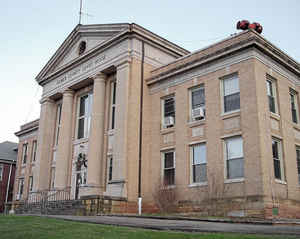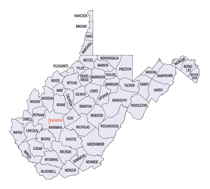West Virginia Counties
There are fifty-five counties in the state of West Virginia. Fifty of them existed at the time of the Wheeling Convention in 1861, before which West Virginia was part of the state of Virginia. The remaining five (Grant, Mineral, Lincoln, Summers and Mingo) were formed within the state after its admission to the United States on June 20, 1863. At that time, Berkeley County and Jefferson County, the two easternmost counties of West Virginia, refused to recognize their inclusion in the state. In March 1866, the US Congress passed a joint mandate assenting to their inclusion.Gilmer County, West Virginia
Gilmer County Education, Geography, and History

Etymology - Origin of Gilmer County Name
For Thomas Walker Gilmer, Governor of Virginia from 1840-41, later a representative in Congress and Secretary of the Navy under Tyler
Demographics:
County QuickFacts: CensusBureau Quick Facts
Early History of Gilmer County, West Virginia
Gilmer County was created by an act of the Virginia General Assembly on February 3, 1845 from parts of Lewis and Kanawha counties. It was named in honor of Thomas Walker Gilmer (1802-1844).
Thomas Walker Gilmer was born on April 6, 1802 in Albemarle County, Virginia. He studied law and was an attorney in Charlottesville. He represented Albemarle County in the Virginia General Assembly from 1829 to 1840, with the exception of two sessions, and served as Speaker of the Assembly in 1838 and 1839. He was elected Governor of Virginia in 1840, but resigned shortly after being elected to take a seat in US House of Representatives. An outspoken critic of Henry Clay, he was appointed the Secretary of the Navy by President Taylor on February 14, 1844. Unfortunately, he was killed by the bursting of a cannon on board the American war ship Princeton at Mount Vernon on February 28, 1844, just two weeks after his appointment. Abel Parker Upshur, the Secretary of State and the namesake of Upshur County, was also killed in the explosion. President Tyler was present for the testing of the new gun, but survived the explosion.
William Lowther and Jesse and Elias Hughes were the first Englishmen to set foot on the land that currently comprises Gilmer County. They explored the area during the autumn of 1772. The first permanent English settler in the county was Peter McCune. He had explored the area shortly after the end of the American Revolutionary War with his father-in-law, Adam O'Brien, and decided to move his family to the county in 1810. He built a cabin at the mouth of Leading Creek. In 1816, William Stalnaker received a grant of 30,000 acres in the county for his service as a Lieutenant in the War of 1812. He built a temporary home and brought his family (wife Elizabeth and son Salathiel) and 20 slaves to the site of an abandoned Indian village on the Little Kanawha River, near the mouth of Mill Seat Run. By 1820, his tobacco plantation was doing very well and he had a two-story brick mansion constructed on is property. A second mansion was later built on the property for his son and, on March 24, 1845, it served as the meeting place for the first session of the Gilmer County court. By that time, a large number of families lived in the area and it was known as DeKalb, named by William Stalnaker in honor of his hero Johann, Baron de Kalb, companion of the Marquis de Lafayette.
At first, the location of the county seat was contested, with several of the county officials, including the county clerk, refusing to attend meetings in Glenville. Once that was settled another problem arose when the deed to the land of the proposed site for the county courthouse in Glenville was contested. Having no where to go, it was agreed to hold the county court, once again, at the home of Salathiel Stalnaker in DeKalb. On April 28, 1846 the county court was moved to the home of William Ball in Glenville where it continued to meet until the court house was completed in 1850. Once it was established that Glenville was to be the center of government, the town of DeKalb began to decline. By the time Glenville was incorporated on March 10, 1856, DeKalb had become a ghost town, literally. It was said that the spirit of Daniel McCune, who was tried, convicted and sentenced for the murder of Jonathan Nicholas in 1843, and who died in prison there, roamed the paths of DeKalb.
To the Stalnaker family's surprise, the county residents selected Glenville over DeKalb as the county seat. Glenville had previously been known as Stewart's Creek, Hartford, and "The Ford." It was called "The Ford" because the old State Road from Weston to Charleston crossed the Little Kanawha River there. Samuel L. Hays laid out the town on the land of William H. Ball in 1845. It was named Glendale by Colonel C. B. Conrad because of the town's location in a glen. William Howell was the first known settler in the town. He built a grist mill there in 1812.
Geography: Land and Water
As reported by the Census Bureau, the county has a total area of 340 square miles (880 km2), of which 339 square miles (880 km2) is land and 1.6 square miles (4.1 km2) (0.5%) is water
Neighboring Counties
Bordering counties are as follows:
- Northeast: Doddridge County; Lewis County
- Northwest: Ritchie County
- Southeast: Braxton County
- Southwest: Calhoun County
Education







